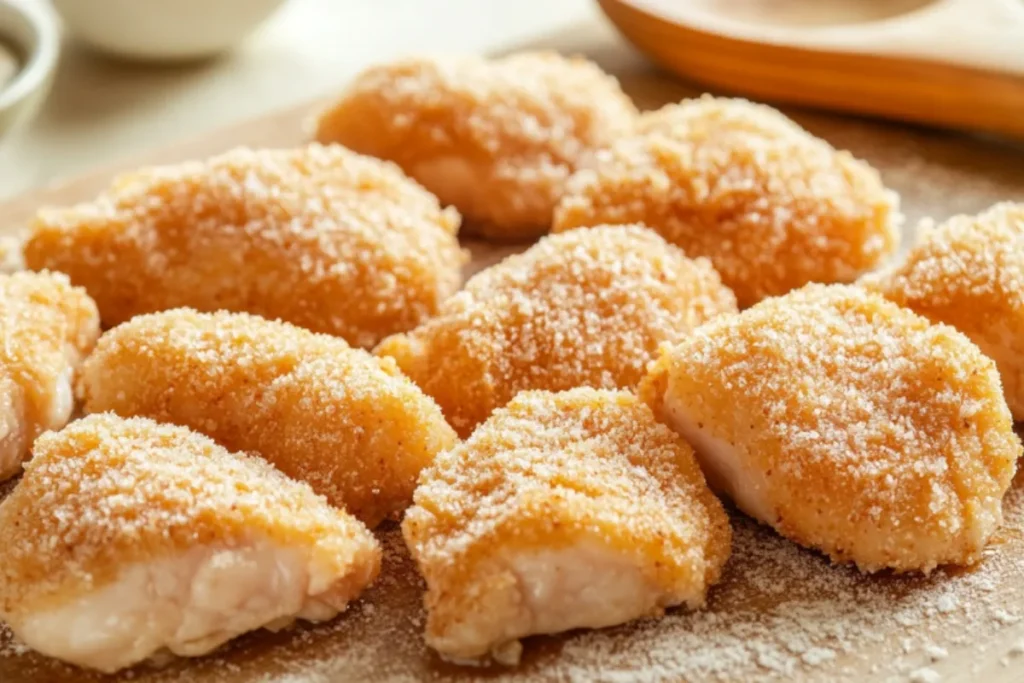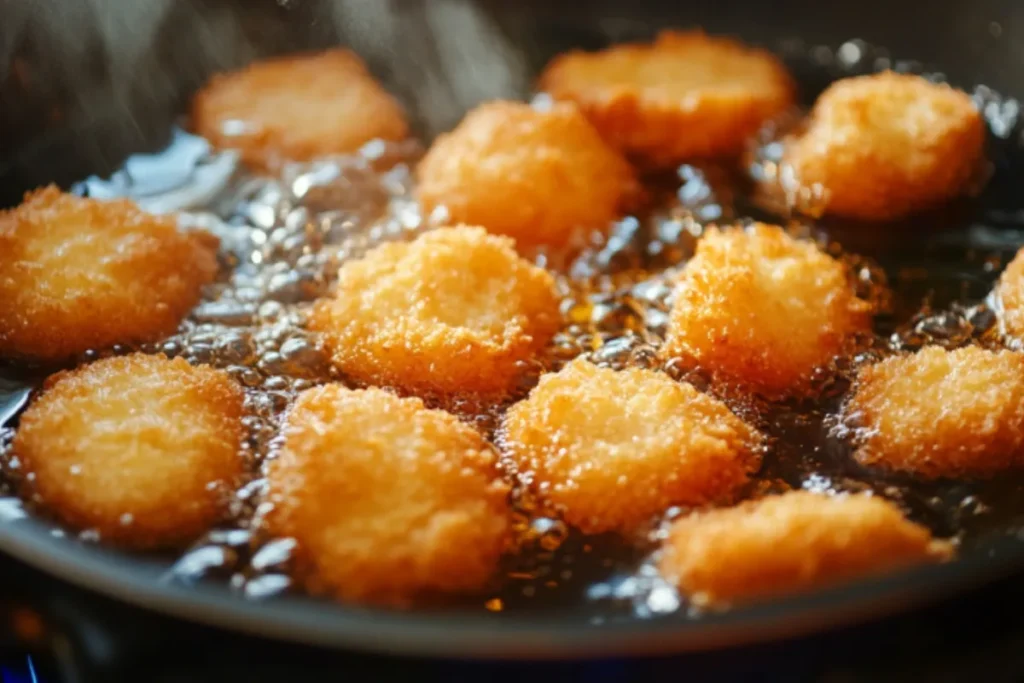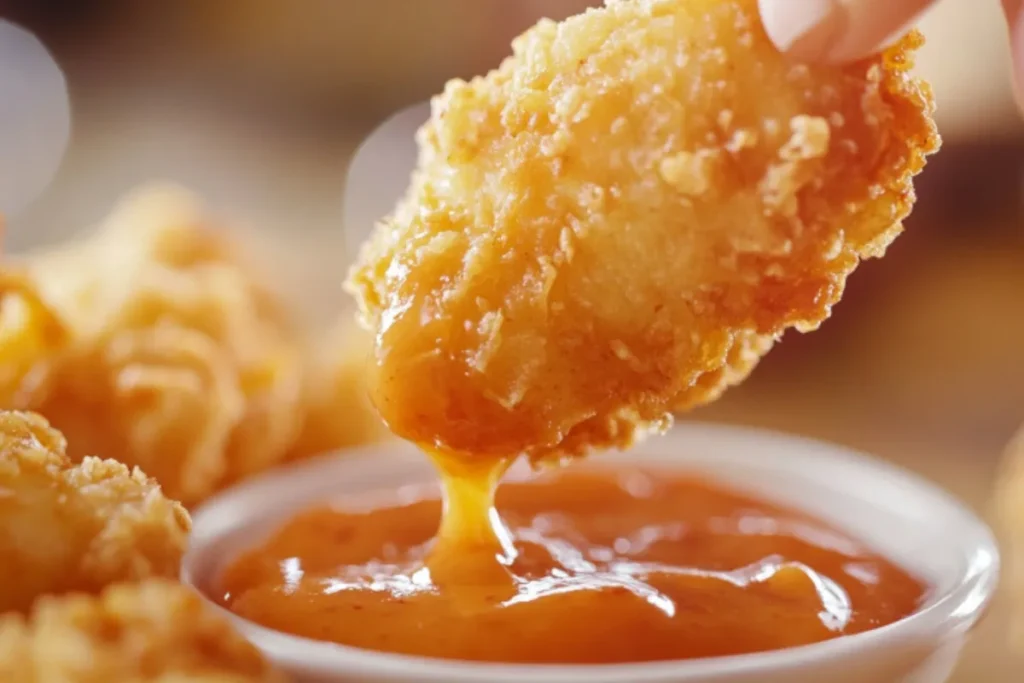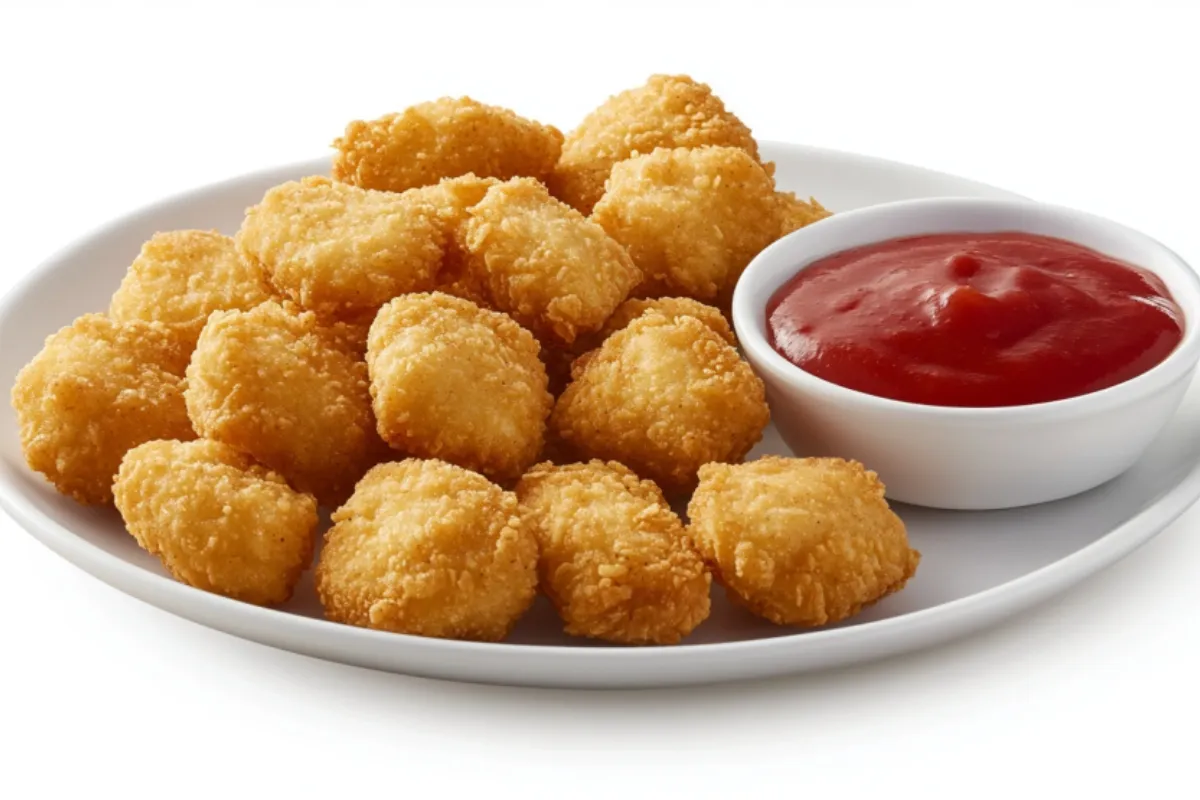The Appeal of Homemade Chicken Nuggets
If you’re anything like me, chicken nuggets have been a staple in your diet since childhood. But here’s the thing: there’s something extra satisfying about making them from scratch. Whether it’s the crispy exterior or the tender, juicy chicken inside, homemade chicken nuggets just hit different! Seriously, when you bite into one, you can taste the freshness. You know exactly what’s in it, and that makes all the difference.
Now, we all know that store-bought frozen nuggets can come in handy when you’re in a rush, but when you make them at home, you’re taking it to another level. The flavors are richer, the texture is on point, and—most importantly—you have control over the ingredients. Honestly, who doesn’t love the idea of biting into a nugget made with love (and a few secret seasonings)?
Why Make Chicken Nuggets at Home?
Making chicken nuggets at home isn’t just about the taste; it’s also about the experience. First off, it’s a great activity for the whole family. If you have kids, get them involved in the breading process. They’ll love dipping the chicken into the flour, then into the egg wash, and finally coating it in breadcrumbs. Plus, you’ll save a few bucks. Instead of buying a bag of frozen nuggets, you can make a batch that lasts longer, tastes better, and doesn’t have any mystery ingredients. You get the best of both worlds: cost-effectiveness and a healthy, customizable snack or meal.
But wait, that’s not all—making chicken nuggets at home can also be a fun experiment in creativity. You can create your own flavor combinations and dipping sauces. Want a spicy twist? Try adding chili powder to the seasoning mix! Or maybe you love sweet and savory combos? Honey mustard dip could be your new go-to. The options are endless, and that’s what makes homemade chicken nuggets so appealing.
Benefits of Homemade Chicken Nuggets vs. Store-Bought
Let’s talk about why homemade chicken nuggets are totally worth it, even though the frozen ones might seem like an easy solution. First, let’s consider the quality. When you make your nuggets at home, you’re in control of the ingredients. You’re using real chicken, not fillers or preservatives. Plus, you can choose your preferred cooking method—whether frying or baking—and adjust the seasonings to suit your taste. You’re not limited to bland or overly salty options.
In addition to taste, homemade chicken nuggets offer a much healthier alternative to their store-bought counterparts. For example, you can use whole wheat breadcrumbs, lower-sodium seasonings, or even bake them instead of frying to reduce the amount of oil. All in all, making chicken nuggets at home gives you peace of mind knowing that you’re serving your family a cleaner, healthier meal without sacrificing flavor.
If you’re looking to step up your dinner game with easy and delicious homemade meals, chicken nuggets are a perfect choice! For a healthier twist, you might also want to try our Healthy Meal Prep Ideas to complement these homemade nuggets with nutrient-packed sides.
Customization and Healthier Alternatives
One of the best things about homemade chicken nuggets is the ability to make them fit your dietary needs. Whether you’re watching your carb intake, trying to avoid gluten, or simply craving a healthier version, the sky’s the limit. Swap out the regular breadcrumbs for almond flour or gluten-free breadcrumbs. If you’re on a low-carb or keto diet, you can even use pork rinds as a substitute.
Want a boost of protein? Add a sprinkle of Parmesan cheese to the breading mixture. For a lighter version, skip the breading altogether and just coat the chicken in a thin layer of seasoned flour. For more ideas on healthy breading alternatives, check out this article on healthy flour substitutes from Healthline. The best part is, no matter what dietary restrictions you may have, you can tweak the recipe and still get the crispy, delicious nuggets you crave. Talk about a win-win!
Want a boost of protein? Add a sprinkle of Parmesan cheese to the breading mixture. For a lighter version, skip the breading altogether and just coat the chicken in a thin layer of seasoned flour. The best part is, no matter what dietary restrictions you may have, you can tweak the recipe and still get the crispy, delicious nuggets you crave. Talk about a win-win!
Key Ingredients in Homemade Chicken Nuggets

Before you start cooking up a batch of delicious homemade chicken nuggets, it’s important to understand the ingredients that come together to make them so irresistible. While there are some variations based on personal preferences, there are a few essential ingredients that form the backbone of any great chicken nugget recipe.
When you break it down, homemade chicken nuggets are simple, but it’s the combination of these ingredients that creates the flavor and texture we all know and love. We’re talking about tender chicken, a crispy breading, and the right seasonings that make every bite an explosion of savory goodness.
While chicken breast is a common choice for nuggets, chicken thighs offer a juicier texture, providing a great balance to the crispy exterior. If you’re looking for more chicken-centric meals, check out our Chicken Cutlets Recipe Guide for more chicken inspiration.
What Holds Chicken Nuggets Together?
So, what exactly holds these nuggets together? It’s a combination of two main factors: the chicken and the binding agents. Chicken breast or thigh (we’ll get into that soon) provides the meat, while binding ingredients like flour, eggs, and sometimes breadcrumbs work to keep the nuggets intact during cooking. These ingredients help create that perfect golden crust while ensuring the juicy chicken inside stays in one piece.
One of the most crucial ingredients in this process is the egg wash. Eggs act as a glue, helping breadcrumbs or flour adhere to the chicken. Without it, the breading might fall off in the cooking process, which can be frustrating. Trust me, you want that crispy coating to stick!
8 Essential Ingredients in Chicken Nuggets
Now, let’s break down the main ingredients you’ll need to make homemade chicken nuggets. These are the ingredients that give your nuggets that tasty, crispy, golden crunch that’s hard to resist:
- Chicken – Whether you’re using chicken breast or thigh, this is the main protein of your nuggets. Chicken breast is leaner and less fatty, while thighs are juicier and tend to be more flavorful.
- Flour – All-purpose flour is usually the go-to binding agent, but you can also use alternatives like rice flour or almond flour if you’re looking for a gluten-free option.
- Eggs – The egg wash is essential for sticking the breading to the chicken. It’s the perfect glue that ensures a crispy exterior.
- Breadcrumbs – These can be plain, panko, or even seasoned breadcrumbs. Panko breadcrumbs are perfect if you want an extra crispy texture.
- Seasonings – Salt, pepper, garlic powder, onion powder, paprika—you name it. The seasonings you choose will really define the flavor of your nuggets. You can also add herbs or cayenne for a little extra kick.
- Baking Powder – Not always necessary, but adding a little baking powder to the breading can give the nuggets a fluffier texture and an even crispier coating.
- Oil – Whether you fry or bake, you’ll need oil to cook your nuggets. If frying, vegetable oil or peanut oil works best for achieving that crispy texture. When baking, you can opt for olive oil spray to help crisp them up.
- Parmesan (Optional) – If you want to add a cheesy flavor to your nuggets, grated Parmesan is a great addition to the breading. It melts beautifully, making the coating extra crispy.
Chicken as the Main Ingredient
At the heart of any chicken nugget is, of course, the chicken. The debate between chicken breast and chicken thigh is one that many home cooks find themselves pondering. So, let’s break it down:
- Chicken Breast: This is the leaner, healthier option. If you’re aiming for a lighter nugget with less fat, chicken breast is your best bet. It’s also a bit drier, which means you need to be extra careful when cooking to prevent it from becoming tough or overcooked.
- Chicken Thigh: On the other hand, chicken thighs are much juicier and more flavorful. They contain more fat, which gives the nuggets a richer taste. If you’re okay with a slightly higher fat content and want a moister nugget, thighs are the way to go.
My personal recommendation? If you’re looking for a healthier nugget, go with chicken breast. But if you’re all about flavor and juiciness, chicken thighs will give you that extra “wow” factor.
Binding Ingredients (Flour, Eggs, etc.)
Now, let’s talk about the binders—these are the ingredients that hold everything together. Flour, eggs, and breadcrumbs (or panko) are the usual suspects.
- Flour: First, you’ll coat your chicken in flour to create a base layer that helps the egg wash stick. This also helps lock in moisture, keeping the chicken juicy on the inside.
- Eggs: After the flour, you’ll dip the chicken into a beaten egg wash. This is the sticky part that makes sure the breadcrumbs adhere properly, which is what gives the nuggets that crispy, crunchy texture.
- Breadcrumbs: Finally, you’ll coat the chicken with breadcrumbs. Panko breadcrumbs are the best for achieving that light, crispy coating. They’re airier than regular breadcrumbs, which gives the nuggets a satisfying crunch. If you’re feeling fancy, you can even season the breadcrumbs with your favorite spices or add a bit of Parmesan for an extra flavor boost.
Seasonings and Flavors in Chicken Nuggets
The seasoning is where you can really get creative. Classic chicken nugget seasoning includes garlic powder, onion powder, and a bit of paprika, but there’s no reason you can’t mix it up. Throw in some cayenne pepper for heat, or add a little dried thyme for an herbaceous twist. You could even experiment with different spice blends like curry powder or Cajun seasoning to give your nuggets a more adventurous flavor.
For a fun twist, try mixing in some grated cheese—Parmesan, cheddar, or even a bit of mozzarella. This not only adds flavor but also helps to make the breading even crispier.
The best part? You can totally adjust the seasonings to match your preferences. Maybe you’re a garlic lover, or perhaps you prefer a bit more heat. That’s the beauty of homemade chicken nuggets: you get to control every detail, from the seasoning to the crunch factor!
How to Prepare Chicken Nuggets
Alright, now that we know the core ingredients and their roles, it’s time to put everything together and start preparing your chicken nuggets. The process may seem simple, but there are a few things you can do to ensure your nuggets turn out perfectly crispy and delicious.
Choosing the Right Chicken (Breast vs. Thigh)
First, decide which type of chicken you want to use: breast or thigh. Both have their pros and cons, but each will give your nuggets a slightly different texture and flavor. If you want lean, tender nuggets, go with chicken breast. For juicier, more flavorful nuggets, chicken thighs are the way to go. Either way, make sure to cut the chicken into even, bite-sized pieces so they cook evenly.
Breading and Coating Techniques

Next up is the breading process. You’ll want to set up a simple breading station: flour, egg wash, and breadcrumbs. This will help ensure the breading sticks to the chicken and doesn’t fall off during cooking.
- Wet vs. Dry Coating for Crunchy Nuggets: To get that satisfying crunch, be sure to dip your chicken pieces in the flour first, followed by the egg wash, and then the breadcrumbs. For an extra crispy coating, some people recommend double-dipping: once in the egg wash and breadcrumbs, and again in the egg wash and breadcrumbs.
- Importance of Dipping and Breading in the Process: The coating not only gives the chicken nuggets their crunch but also locks in moisture, keeping the chicken juicy. Be sure to press the breadcrumbs firmly onto the chicken to ensure they adhere well, especially if you’re aiming for extra crispiness.
Troubleshooting Common Homemade Chicken Nugget Issues
While making homemade chicken nuggets is pretty straightforward, sometimes things don’t go quite as planned. You might end up with soggy nuggets, or perhaps they don’t get as crispy as you’d hoped. Don’t worry—this section is all about troubleshooting those pesky issues and getting your nuggets just right.
Why Are My Homemade Chicken Nuggets Soggy?
A soggy nugget is one of the most common frustrations when making homemade chicken nuggets. But fear not, it happens to the best of us! So, what causes soggy chicken nuggets?
Well, there are a few culprits at play here. First, if you don’t get the oil temperature right, your nuggets may soak up too much oil, making them greasy and soggy. Additionally, if you use too much moisture in your breading (think: too much egg wash or wet breadcrumbs), it can result in a soggy exterior.
Another factor? The cooking time. If you don’t cook your nuggets long enough or at the correct temperature, the breading might not crisp up properly.
Common Mistakes Leading to Soggy Nuggets
Let’s take a closer look at the common mistakes that lead to soggy nuggets:
- Too Much Egg Wash or Wet Breading: If your breading is too wet, it’ll soak up oil during frying, which results in soggy nuggets. Make sure to let any excess egg wash drip off before coating with breadcrumbs.
- Low Cooking Temperature: If your oil isn’t hot enough (around 350°F to 375°F), the nuggets will absorb more oil rather than crisping up, leaving them soggy.
- Overcrowding the Pan: Placing too many nuggets in the frying pan at once can lower the oil temperature, resulting in less crispy chicken. It’s best to fry in small batches.
- Not Draining the Nuggets Properly: After frying, be sure to place your nuggets on a paper towel-lined plate to absorb any excess oil. This helps avoid that greasy, soggy texture.
Tips for Achieving Crispy, Golden Nuggets
Getting crispy, golden chicken nuggets is all about managing a few key elements: oil temperature, breading technique, and cooking time. Here are some tried-and-true tips for perfecting your crispy nuggets:
- Use the Right Oil: For deep frying, oils with a high smoke point, like vegetable oil, canola oil, or peanut oil, are your best bet. They can handle the high heat without burning, giving you that crispy texture without overcooking the meat inside.
- Proper Oil Temperature: As mentioned, aim for a temperature of 350°F to 375°F. You can test the oil by dropping in a small piece of bread; if it turns golden brown in about 30 seconds, your oil is ready.
- Cook in Batches: Don’t overcrowd the pan! Frying too many nuggets at once lowers the temperature of the oil and results in soggy nuggets. Give your chicken room to crisp up by cooking in smaller batches.
- Double Breading: For extra crunch, try double-breading your nuggets. Coat your chicken in flour, dip in egg wash, coat in breadcrumbs, then repeat the process. This creates a thicker coating that gives you a crunchier result.
- Bake with a Rack: If you’re baking your nuggets, place them on a wire rack over a baking sheet. This allows hot air to circulate around the nuggets, keeping them crispy on all sides. You can also spray them lightly with oil or butter to boost the crisp factor.
Adjusting Oil Temperature and Cooking Time

The most important thing when frying chicken nuggets is to maintain a consistent oil temperature. If the oil is too hot, your nuggets might burn on the outside while remaining raw inside. Conversely, if the oil is too cool, the chicken will absorb too much oil, making them greasy.
Here’s a quick guide to oil temperature and cooking times:
- Frying: Heat the oil to about 350°F to 375°F. Fry the nuggets in batches for 3-4 minutes, or until golden brown and crispy.
- Baking: Preheat your oven to 400°F. Arrange the nuggets on a wire rack and bake for 15-20 minutes, flipping halfway through.
Be sure to check the internal temperature of your chicken nuggets with a thermometer—aim for 165°F to ensure they’re fully cooked.
Avoiding Excess Moisture in Coating
As mentioned earlier, moisture is the enemy of crispy chicken nuggets. Too much moisture in your breading can prevent it from crisping up and leave your nuggets soggy.
To avoid this, make sure to:
- Let the Egg Wash Drip Off: After dipping your chicken in the egg wash, give it a little shake to remove excess egg before breading. This will prevent the coating from getting too soggy.
- Dry Your Chicken: Before breading, make sure your chicken pieces are as dry as possible. Pat them down with paper towels to remove any excess moisture from the surface.
- Use Panko for Extra Crunch: Panko breadcrumbs are great for getting a super crunchy coating. Their airy texture helps create a crispy surface, even if the chicken releases a little moisture during cooking.

How to Cook Chicken Nuggets: Frying vs. Baking
When it comes to cooking homemade chicken nuggets, there are two main options: frying and baking. Both methods have their pros and cons, so let’s break them down to help you choose the best option for your nuggets.
Does Chick-fil-A Fry or Bake Their Chicken Nuggets?
If you’re wondering how fast-food chains like Chick-fil-A cook their nuggets, the answer is: they fry them! Chick-fil-A uses a pressure fryer to cook their nuggets, which creates that signature crispy texture while keeping the chicken inside juicy and tender. The pressure fryer allows the nuggets to cook quickly at high temperatures, resulting in a perfect crunch.
However, frying isn’t the only way to make nuggets crispy. If you’re looking for a healthier alternative, you can bake them in the oven, and you can still achieve a similar crunch if you use the right technique.
Which Method Works Best for Homemade Nuggets?
Both frying and baking are excellent methods for cooking chicken nuggets, but each has its own advantages.
- Frying: This is the classic method and results in a super crispy, golden exterior. The downside is that frying can be messy, and it’s not as healthy as baking since it involves a lot of oil. If you want crispy, restaurant-style nuggets, frying is the way to go.
- Baking: Baking chicken nuggets is a healthier option, and it’s a great choice if you’re trying to cut down on oil. Baked nuggets can still be crispy, especially if you use a wire rack and lightly spray them with oil before baking. The downside is that baking takes a little longer than frying, and you might need to adjust the temperature to get the perfect crunch.
Pros and Cons of Frying Chicken Nuggets
- Pros:
- Crispy, golden texture
- Quick cooking time
- Classic chicken nugget flavor
- Ideal for larger batches
- Cons:
- Messy and oily
- Higher fat content
- Can be easy to overcook if not monitored closely
Benefits of Baking for Healthier Nuggets
- Pros:
- Healthier option with less oil
- Less mess
- Allows you to cook more evenly
- Can be done in large batches
- Cons:
- Takes longer than frying
- May not be as crispy as frying
- Requires a wire rack or flipping halfway for the best texture
FAQs
What Holds Chicken Nuggets Together?
When making homemade chicken nuggets, the key to holding them together lies in the right binding ingredients. Flour, egg wash, and sometimes breadcrumbs or cornstarch are what help the chicken pieces stick together and form that crunchy outer coating. These ingredients create a layer that helps keep the chicken intact during cooking. Eggs act as a glue, while flour helps the breading adhere to the chicken. A nice, crispy coating is formed through proper breading techniques, which lock in moisture and flavor!
What Are the 8 Ingredients in Chicken Nuggets?
So, you’re curious about what goes into a batch of chicken nuggets, right? The basic 8 ingredients include:
- Chicken (either breast or thigh, your choice!)
- Flour (helps with binding)
- Eggs (for the egg wash, which helps the breading stick)
- Breadcrumbs (either plain or panko for extra crunch)
- Salt (for seasoning)
- Pepper (a must for flavor)
- Garlic powder (for extra taste!)
- Oil (for frying or brushing if baking)
Each ingredient plays a role in making sure your nuggets turn out flavorful and crispy. You can also adjust these ingredients to suit your taste—add some cayenne pepper for heat or experiment with herbs for a unique twist!
Does Chick-fil-A Fry or Bake Their Chicken Nuggets?
Ah, the classic question about Chick-fil-A. You may be wondering if their famous nuggets are baked or fried. The answer is fried! Chick-fil-A uses a pressure fryer, which cooks the nuggets quickly under high pressure, locking in the moisture and achieving that signature crispiness. While you might not have access to a pressure fryer at home, you can get close to that texture by frying your nuggets in hot oil (around 350°F).
That said, if you prefer a healthier option, you can always bake your homemade chicken nuggets, though they may not have quite the same crispy crunch as fried nuggets. Either way, you’ll be able to make a delicious batch at home!
Why Are My Homemade Chicken Nuggets Soggy?
Soggy homemade chicken nuggets can be super frustrating, but don’t worry—this problem is often easy to fix. The primary reason for sogginess is usually a result of either using too much egg wash or not frying at the correct temperature. If the oil is too cool, the coating will absorb excess oil, which leads to sogginess. To prevent this, make sure your oil is hot enough (350°F to 375°F), avoid overcrowding the pan, and be sure to drain the nuggets on paper towels after frying to remove any excess oil.
Another trick is to double coat your nuggets for extra crunch. This will help create a thicker, crispier outer layer, making it harder for moisture to seep in.
How Can I Make Chicken Nuggets More Crispy?
Want to take your homemade chicken nuggets to the next level? Here are a few tips for achieving an even crispier finish:
- Use Panko Breadcrumbs: Panko breadcrumbs are light and airy, giving your nuggets an extra crispy coating.
- Double Coat: For that ultra-crunchy texture, try double breading your nuggets. Dip them in flour, then egg wash, coat with breadcrumbs, and repeat. The extra layer helps achieve that crispiness!
- Bake on a Wire Rack: If you’re baking your nuggets, place them on a wire rack. This allows the heat to circulate around them, helping the breading stay crispy.
- Fry at the Right Temperature: As mentioned before, make sure your oil is hot enough. Oil that’s too cold will make your nuggets greasy, while oil that’s too hot can burn them on the outside while leaving them undercooked inside.
Can I Freeze Homemade Chicken Nuggets?
Absolutely! Freezing homemade chicken nuggets is a great way to prepare meals in advance. Once your nuggets are breaded and before you cook them, lay them out on a baking sheet in a single layer and freeze until solid. Then, transfer them to a freezer-safe bag or container. When you’re ready to eat, you can bake or fry them directly from the freezer—just be sure to cook them a bit longer to ensure they’re heated all the way through.
Pro Tip: If you freeze the nuggets before cooking, they’ll keep their crispiness when cooked from frozen.
How Long Can Homemade Chicken Nuggets Be Stored?
Homemade chicken nuggets can be stored in the refrigerator for up to 3-4 days. Make sure they’re completely cooled before placing them in an airtight container. If you want to store them for a longer period, freezing is your best bet. In the freezer, they can last up to 3 months.
When reheating, you can bake them in the oven at 375°F for 10-15 minutes, or until they’re heated through and crispy. You can also reheat them in an air fryer for a few minutes for that freshly fried texture.

